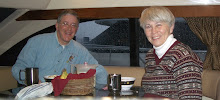
We have now entered the Trent Severn Waterway; the waterway with canals and locks to make it navigable connecting a series of lakes with the rivers, began in 1837 but took 90 years to complete. It was intended to move wheat from the prairies to Lake Ontario, but by the time it was finished, grain was being transported by train. It is 240 miles long with 42 locks.
It sounds strange to say we are cruising up
 the Trent River today. In my home town the mouth of the Trent River opens into the Neuse River
the Trent River today. In my home town the mouth of the Trent River opens into the Neuse River in New Bern at the Bridge learned to swim Point marina were we left on our voyage. The Trent River is where I and water ski; I feel a great affinity with the tea colored water, rippling waves, wooded banks and neighborhoods along it, even including the waterway up into the basin where my parents lived on Gangplank road. The dock there was the hangout for a large blue heron that my Momma liked to see there. So now I am on the Trent River in Ontario and it seems very different. The water is very clear creating a very white wake as the boat cuts through it. In many
in New Bern at the Bridge learned to swim Point marina were we left on our voyage. The Trent River is where I and water ski; I feel a great affinity with the tea colored water, rippling waves, wooded banks and neighborhoods along it, even including the waterway up into the basin where my parents lived on Gangplank road. The dock there was the hangout for a large blue heron that my Momma liked to see there. So now I am on the Trent River in Ontario and it seems very different. The water is very clear creating a very white wake as the boat cuts through it. In manyplaces the banks are naturally rocky as well as the stone walls built to protect the bank. And then, of course, there are the locks and the rapids. There are highlands and hills that are different than New Bern, and the fall of the water provides an idea location for the many dams and hydroelectric plants we are passing. However, as we moved farther from Trenton, there were patches of marsh grass and homes along the way
 that could be the Trent River in NC. We
that could be the Trent River in NC. We saw several blue herons and even a snowy white egret today that looked like home. The sea gulls are certainly familiar friends as well.
saw several blue herons and even a snowy white egret today that looked like home. The sea gulls are certainly familiar friends as well.The last lock we did today was Ranney Falls which was a double
 lock and ascended 48 feet. After passing through, we tied up on the stone wall to walk over and see Ranney Gorge and the suspension bridge which was just built in 2003. I was very brave to walk half way
lock and ascended 48 feet. After passing through, we tied up on the stone wall to walk over and see Ranney Gorge and the suspension bridge which was just built in 2003. I was very brave to walk half way across because the wind was moving it and it hung about 30 feet above the moving current. It was next to the hydroelectric plant which provides power for about 4400 homes in the area.
across because the wind was moving it and it hung about 30 feet above the moving current. It was next to the hydroelectric plant which provides power for about 4400 homes in the area.Tonight we will spend the night at Campbellford named after Scottish brothers Robert and David Campbell who were granted 1800 acres here for their service in the Napoleonic wars in 1832. This was the shallowest place for crossing the Trent River so it was the preferred “ford”; hence the name Campbellford. The place was known for its large woolen mill which flourished here for almost 100 years. We are docked across the river from the Old Mill Park where the mill stood,
 and once again it is raining. After supper we walked to find the local Baptist church on Grand Road which we discovered surfing the internet. Also, happily, back at the boat we can get a TV station with Olympic Games coverage and it is even in English. While most of the coverage is of Canadian athletes (go figure), we did get to see Michael Phelps win his gold medal in the 400 meter medley.
and once again it is raining. After supper we walked to find the local Baptist church on Grand Road which we discovered surfing the internet. Also, happily, back at the boat we can get a TV station with Olympic Games coverage and it is even in English. While most of the coverage is of Canadian athletes (go figure), we did get to see Michael Phelps win his gold medal in the 400 meter medley.


No comments:
Post a Comment